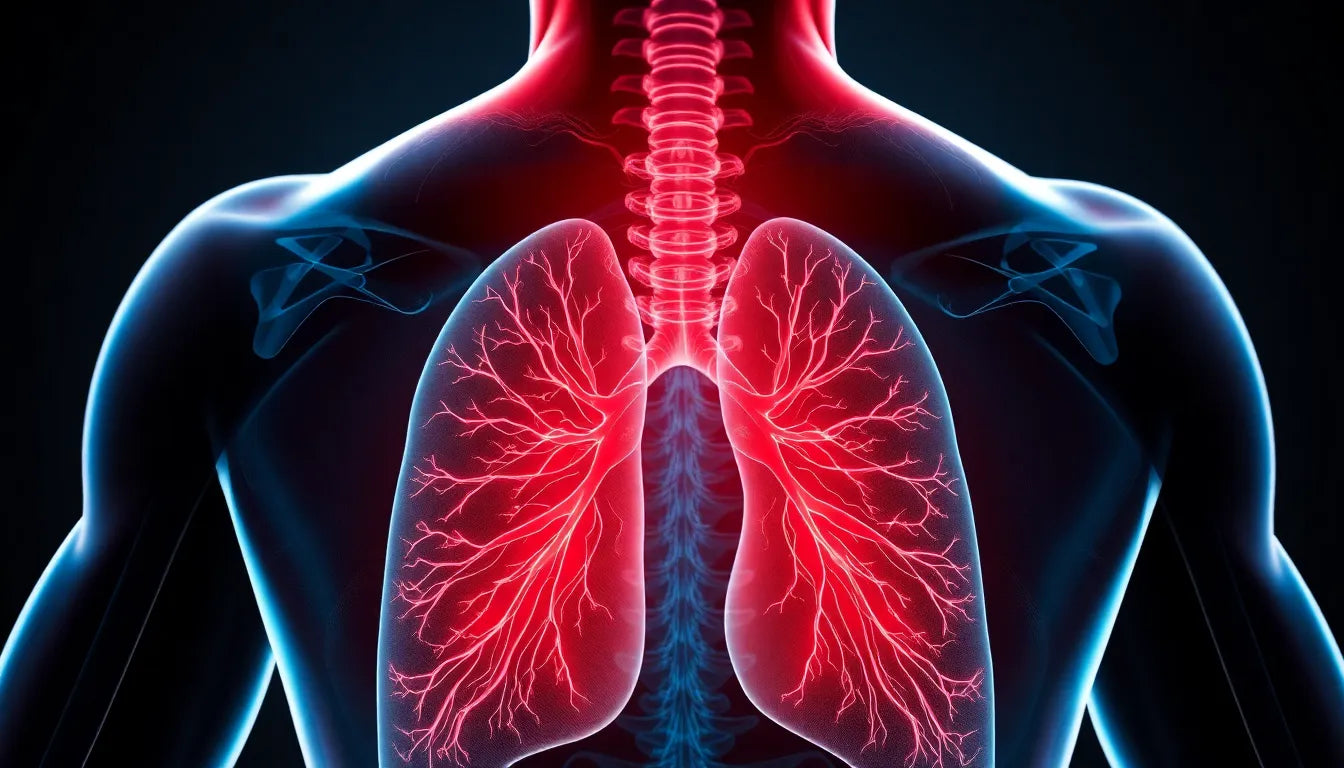When considering the symptoms of pneumonia, most people think of fever, cough, and difficulty breathing. However, there's a surprising connection between pneumonia and back pain that often goes unnoticed. This lesser-known symptom can complicate diagnosis and delay treatment, underscoring the importance of recognizing atypical symptoms for timely medical intervention.
understanding pneumonia and referred pain
Pneumonia is a common yet potentially serious lung infection that can significantly impact one's health if not addressed promptly. While the primary symptoms are well-known, the concept of "referred pain" is crucial in understanding how pneumonia can manifest beyond the respiratory system. Referred pain occurs when pain is felt in a different part of the body than its source, such as back pain linked to lung infections. This phenomenon can make it challenging to pinpoint the root cause of discomfort, leading to possible misdiagnosis.
importance of awareness in symptom recognition
Misattributing back pain to muscular issues is a common mistake that can lead to a delayed diagnosis of pneumonia or pleuritis, a condition where the lining of the lungs becomes inflamed. The risks associated with such delays are significant, as untreated pneumonia can lead to severe complications. For both patients and healthcare providers, understanding these symptoms is vital. Recognizing the potential link between back pain and lung infections can facilitate earlier intervention, improving treatment outcomes and reducing the risk of complications.
By raising awareness about this hidden connection, we aim to empower individuals to seek medical advice when experiencing unusual back pain, especially when accompanied by respiratory symptoms. Understanding the full spectrum of pneumonia symptoms, including the possibility of referred back pain, can make a significant difference in achieving timely and effective medical care.
understanding pneumonia and its symptoms
Pneumonia, a lung infection, presents with a range of symptoms that are important to recognize for timely treatment. Typical symptoms include fever, a cough that may produce phlegm, chest pain, breathlessness, fatigue, and muscle aches. However, back pain can also be a symptom, especially when pneumonia leads to pleuritis, an inflammation of the lung lining. This inflammation can cause sharp, one-sided back pain, particularly noticeable when taking deep breaths or coughing.
mechanisms of pain in pneumonia
The association between pneumonia and back pain is often due to the mechanics of referred pain. Lung infections can exert pressure on the diaphragm and surrounding structures, leading to pain that radiates to the back. This pain is typically sharp and can worsen with movements that involve the chest, such as deep breathing or coughing. Additionally, referred pain can extend to the shoulder, making it challenging to diagnose the exact source of discomfort.
medical insights into back pain and pneumonia
Insights from Anodyne.dk highlight that back pain often goes unrecognized as a symptom of pneumonia. This oversight can lead to delays in diagnosis and treatment, especially when back pain is mistaken for a musculoskeletal issue. Anodyne.dk emphasizes the importance of considering back pain as a potential indicator of lung infections, particularly when accompanied by respiratory symptoms.
Moreover, Apoteket.dk discusses pleuritis, a common complication of pneumonia, which can manifest as sharp, localized pain in the chest or back. Understanding the overlap between symptoms of pneumonia and pleuritis is crucial for accurate diagnosis and effective treatment.
visual aids for understanding back pain causes
Visual aids such as tables or infographics can be instrumental in differentiating between musculoskeletal back pain and infection-related back pain. A table could outline the characteristics of each type of pain, helping individuals identify whether their symptoms might be linked to a lung infection. Additionally, a flowchart could guide individuals on steps to take when experiencing back pain alongside respiratory symptoms, emphasizing the need for medical evaluation.
By understanding the mechanisms and implications of back pain in the context of pneumonia, individuals can better recognize when to seek medical attention. This awareness is crucial for timely intervention, potentially preventing complications associated with delayed treatment of lung infections.
when to seek medical attention
Recognizing when to seek medical attention is crucial when dealing with back pain that might be linked to pneumonia. If you experience back pain alongside respiratory symptoms such as fever, persistent cough, or breathlessness, it is essential to consult a healthcare professional promptly. These symptoms together could indicate a more serious underlying condition that requires medical intervention.
A checklist of red flags can help determine when immediate medical evaluation is necessary. These include sudden and severe back pain, difficulty breathing, high fever, confusion, or a significant change in your overall health status. Early diagnosis and treatment are vital in preventing complications associated with pneumonia and related conditions like pleuritis.
prevention and management strategies
Preventing pneumonia and managing back pain effectively involves a combination of proactive healthcare measures and lifestyle adjustments. Vaccination is a key preventive strategy against pneumonia, especially for high-risk groups such as the elderly and individuals with chronic health conditions. Maintaining good respiratory health through regular exercise, a balanced diet, and avoiding smoking can also reduce the risk of lung infections.
For managing non-infectious back pain, ergonomic solutions can play a significant role. Anodyne offers a range of ergonomic products designed to support proper posture and alleviate discomfort. For instance, using a lumbar support belt can help relieve strain on the back, making it easier to manage daily activities without exacerbating pain. However, it's important to address any underlying medical issues first, ensuring that back pain is not a symptom of a more serious condition like pneumonia.

Lumbar support belt
Supports and relieves lower back pain with adjustable compression for daily comfort.

Men's Posture Shirt™ - Black
Posture-correcting shirt activates muscles and can relieve tension and discomfort.
frequently asked questions
can pneumonia cause back pain?
Yes, pneumonia can cause back pain, particularly if it involves pleuritis, which can lead to sharp, one-sided back pain that worsens with breathing or coughing.
how can I tell if my back pain is related to pneumonia?
If your back pain is accompanied by symptoms such as fever, cough, and breathlessness, it may be related to pneumonia. In such cases, seeking medical advice is important for an accurate diagnosis.
what should I do if I suspect my back pain is linked to a lung infection?
If you suspect your back pain is linked to a lung infection, contact a healthcare provider for a thorough evaluation and appropriate testing. Early intervention can prevent complications.
are there ergonomic solutions for managing general back pain?
Yes, ergonomic aids such as lumbar support belts and posture-correcting products can help alleviate discomfort from non-infectious back pain. However, it's crucial to address any underlying medical issues first.
In conclusion, understanding the connection between pneumonia and back pain is essential for timely medical intervention. By staying informed and proactive about your health, you can ensure better outcomes and reduce the risk of complications. Always seek medical guidance when experiencing unusual back pain, especially when accompanied by respiratory symptoms.
Kilder
- Apopro. ”Lungebetændelse.” Apopro.
- Lungeforeningen. ”Lungebetændelse.” Lungeforeningen.
- Nordsjællands Hospital. ”Lungebetændelse - Bakteriel.” Nordsjællands Hospital.
- Apoteket. ”Lungebetændelse.” Apoteket.
- Netdoktor. ”Lungebetændelse (Pneumoni).” Netdoktor.
- Sundhed.dk. ”Lungebetændelse.” Sundhed.dk.
- Gentofte Hospital. ”Lungebetændelse (Pneumoni).” Gentofte Hospital.
- Statens Serum Institut. ”Lungebetændelse.” Statens Serum Institut.
- Min Medicin. ”Lungebetændelse.” Min Medicin.


















